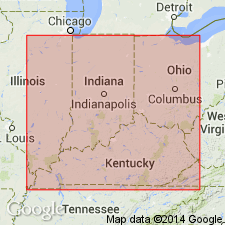
- Usage in publication:
-
- Big Rock Member
- Modifications:
-
- Named
- Dominant lithology:
-
- Limestone
- Shale
- AAPG geologic province:
-
- Cincinnati arch
Summary:
The Louisville Limestone at its type section in north-central KY and in southern IN is here divided into three newly named members: Big Rock, Shanks Quarry, and Cross Hill. The Big Rock consists of ten ledges, the lower seven named in this report, the upper three from the terminology of the quarrymen of the late 1800's. The seven lower ledges are not exposed at the type section of the Louisville Limestone. Ascending, these ten ledges are called the First encrinital limestone, First shale, Second encrinital limestone, Second shale, Argillaceous limestone, PENTAMERUS coquina, 3 Foot limestone, Great Granddad (worm-burrowed limestone), Granddad (limestone with marcasite nodules), and Bottom Curb (dolomitic limestone). Chert nodules are scattered throughout. Total thickness of these ledges is 40 ft at the type locality. Thickness ranges from 35 to 42 ft, and it is the most persistent member of the formation, extending throughout the study area of this report. North of Lexington, IN, the Big Rock diminishes to 12 ft and is overlain by the Geneva Dolomite Member of the Jeffersonville. Overlies the Waldron Shale throughout the area.
Source: GNU records (USGS DDS-6; Reston GNULEX).
For more information, please contact Nancy Stamm, Geologic Names Committee Secretary.
Asterisk (*) indicates published by U.S. Geological Survey authors.
"No current usage" (†) implies that a name has been abandoned or has fallen into disuse. Former usage and, if known, replacement name given in parentheses ( ).
Slash (/) indicates name conflicts with nomenclatural guidelines (CSN, 1933; ACSN, 1961, 1970; NACSN, 1983, 2005, 2021). May be explained within brackets ([ ]).

